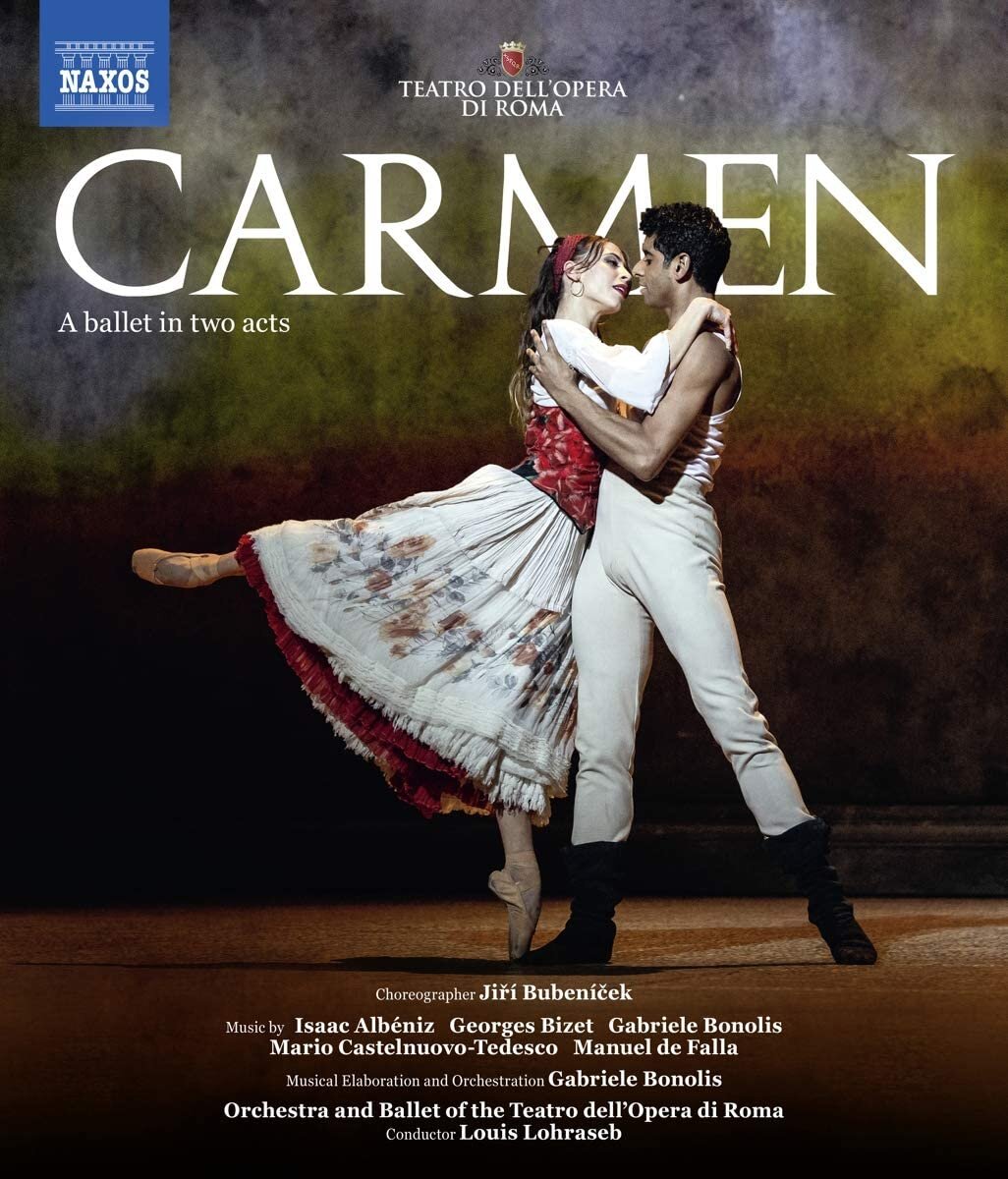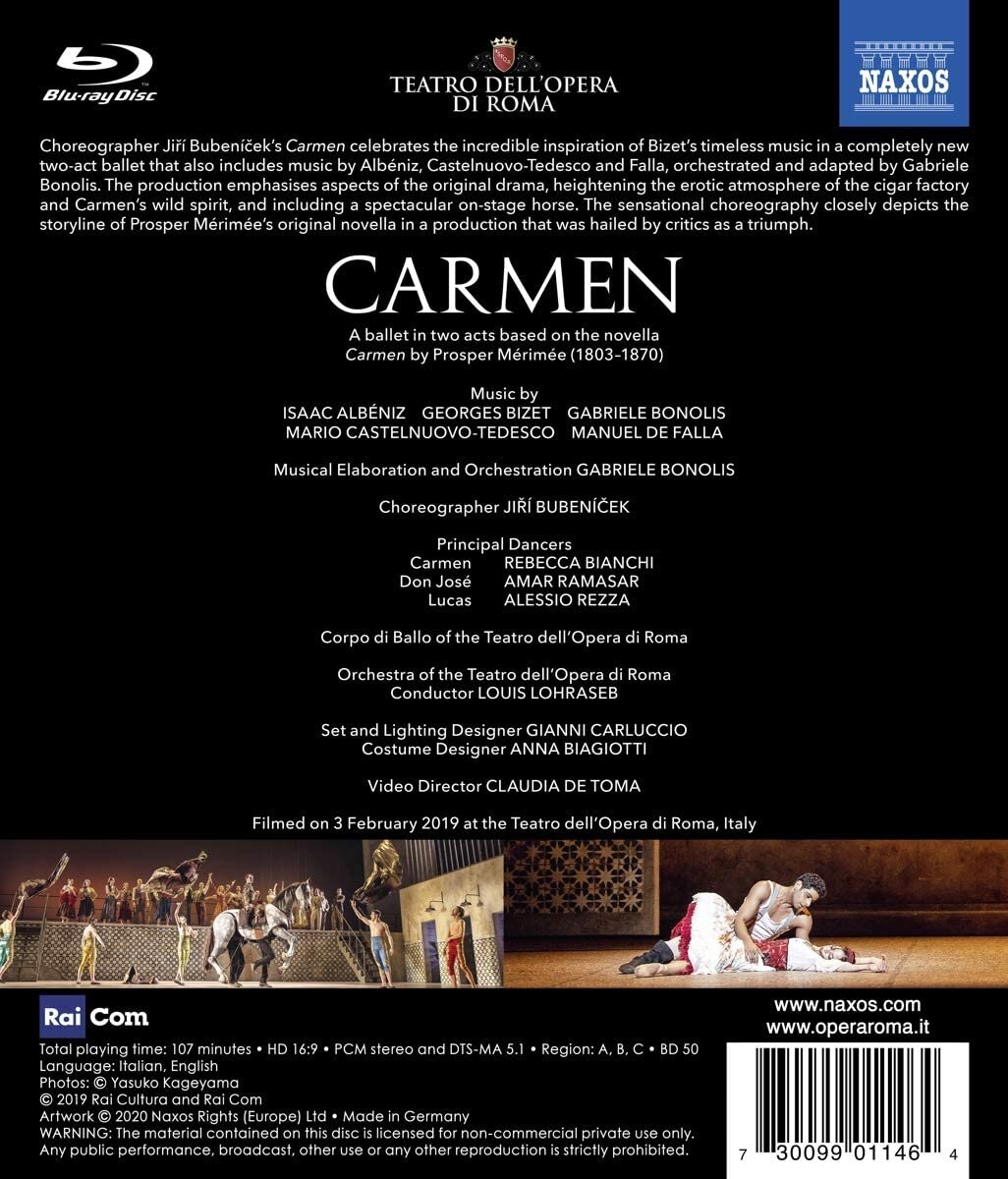

Carmen ballet. Choreography by Jiří Bubeníček. Music by Isaac Albéniz, Georges Bizet, Gabriele Bonolis, Mario Castelnuovo-Tedesco, and Manuel de Falla adapted by Gabriele Bonolis. Recorded 2019 at the Teatro dell’Opera di Roma. Stars Rebecca Bianchi (Carmen), Amar Ramasar (Don José), Alessio Rezza (Lucas), and the Corpo di Ballo of the Teatro dell’Opera di Roma. (No credits in the package for the supporting dancers.) Louis Lohraseb conducts the Orchestra of the Teatro dell’Opera di Roma. Set and lighting design by Gianni Carluccio; costume design by Anna Biagiotti. Directed for TV by Claudia De Toma. Released 2020, disc has 5.1 HD Master Audio sound. Grade: C+
Bubeníček’s Carmen ballet is based on the 1845 novella Carmen by Prosper Mérimée. It is not a danced version of Bizet’s Carmen opera. But Bubeníček does use music from the opera along with selections from 4 Spanish composers.
The novella Carmen was written in the then popular episodic style of fiction in which the author writes of events he claims to have personally experienced or learned of as a reporter. Picking up on this, Bubeníček puts on the stage a tall, thin “writer” character who represents Prosper Mérimée. The screenshot left below is both the first scene in the ballet and the last event in the story. The writer has finished interviews with Don José and gives him a last smoke. Then the executioners hang Don José. The screenshot right below is the first event in the story, where the writer meets Carmen, the notorious Gypsy. He gives her a cigar, and she pickpockets his watch. The writer is hooked and becomes a Carmen fan:
Before we learn more about Carmen, let’s consider the ballet venue. We are in the main auditorium of the Opera and Ballet of Rome, which has a large proscenium and vast fly space. Well, the fly certainly looks big in the shot below that TV director Claudia de Toma uses several time in her video. I’ve not in 12 years of reviewing fine-arts video seen this view before:
Showing off a huge stage is perverse when shooting a production by a small ballet company. The Rome Opera Ballet has about 75 dancers. Only in the final bullfight scene will this company be able to put more than 15 dancers on stage. For example, see below the scene of a plaza. 14 soldiers and cigarette girls represent Seville. This is so different from how a major opera company stages this. The opera will put 60 singers and extras on the plaza to make you feel you are right there in Seville. How could the Rome Opera Ballet compete with such firepower? They would have to move to a smaller venue or build an elaborate set that shrinks the stage. Then the dancers would not look so lonesome:
The Gypsy life is portrayed by a meager 6 dancers:
Carmen holds sway over the troops to the famous Habanera music from Bizet:
I can’t believe the ugly set was designed for this Carmen. The ballet company must have improvised after finding it stored in the opera warehouse. Weak video projections on the rear wall try to dress things up. In the scene below the cigarette girls look lost in their factory:
But at least we at home get to see the girls better than the live audience could:
Next we see below left the end of the fight when Carmen slashes another girl’s face. Below right is an unfortunate fly shot of the fight. This only accentuates how tiny the small forces on stage appear:
Carmen seduces Don José into letting her escape:
The Lieutenant has a party at his house. Carmen dances for the guests and Don José stands guard. Both the Lieutenant and Don José are now in love with Carmen, and both will die for it:
After the party Carmen makes a date with Don José to meet at the Gypsy tavern. They make love. But when Don José wakes up, Carmen has gone and left him alone:
Don José searches for Carmen. The video projection of streets is partially blocked by the strange set:
Don José finds Carmen with the Lieutenant. Don José kills him. Now our hero must join Carmen in the Gypsy life:
Below same set, but the video projection shows a mountain and dead trees, which means we are in the wilderness (even if the walls, doors, and metal staircases suggest otherwise). Bubeníček puts a horse on stage operated by two men clad in black. The print critics who say this live felt that this prop was a distraction. But everyone agrees that the two men supporting the horse were extremely skilled and made the horse look as realistic as possible:
Don José is getting used to Gypsy ways. Below he meets two girls. They must be Frasquita and Mercédes, who were, I think, characters in Mérimée’s novella. It’s harder to figure out who the Gypsy men are:
Earlier I criticized De Toma’s fly-shots. But one of these shots was effective: the shadow of a man moving quietly forward with a knife ready to use:
Turns out the man with the knife is Garcia, the husband of Carmen, whom Carmen just got released from jail! The outlaw life and keeping two lovers happy stresses Carmen. She flees Spain by crossing over to Gibraltar (under British rule):
Gibraltar is full of opportunity for Carmen. Soon she is the favorite of the Governor himself:
Don José, a wanted man, goes underground disguised as an orange peddler. When he finds Carmen, he brings the smugglers with him to take her back. There follows a disastrous (and confusing) battle between the Gypsies and the British army. The fight ends with Don José killing Garcia! Now the deserter is wanted for murder in two countries!
Carman survived the Battle of Gibraltar and is back in Seville. She has taken up with Lucas, the Toreador:
I’ll not spoil everything. But you know what happens to Carmen, so I’ll show you her death below. And Don José, now wanted for three murders, soon will wind up smoking that last cigar:
The big problem with the episodic nature of this production is the difficulty the viewer has keeping up with who is who and what is happening to them in an art from where nobody can tell you anything.
The Carmen opera with it’s Micaëla subplot is easier to follow than the ballet. The opera story is simple: Carmen is wild and Don José is weak. Together they crush the hopes of the virgin who truly loves Don José. Therefore, they both deserve to die. The story in the Novella and Bubeníček‘s ballet goes on and on. So what’s Bubeníček’s moral? Well, try this: if you drive drunk enough times, eventually you will die crashing into a bridge abutment.
Print critics who saw this live said audiences were enthusiastic. The writers gave nice reviews. Maybe they all got free tickets. Maybe this looked better live than in the recording. The video production is weak with the weird set on the huge stage often dwarfing the dancers. But I still enjoyed the acting and dancing. The music gathered from many sources was charming. It was fun hearing the familiar Bizet tunes used in new ways.
I ran the numbers on this video content from TV director Claudia de Toma, who is new to fine-arts Blu-ray. I did a scientific samples of about 22% of the video segments in the file. The sample says the pace is less that 5 seconds per video clip. About 67% of the clips show the whole bodies of the dancers, which is OK considering that this big stage tends to make the dancers look bad. But still the diagnosis of rampant DVDitis is inescapable. I think the libretto and choreography here gets a B+. With adjustments, Bubeníček can maybe whip this into an A level ballet. The weak set has to knock the grade down to a B at best. And then the DVDitis results in a C. But I hate to do this to poor Bubeníček, who did the best he could with lackluster support from the house and a new videographer. I’ll go for a C+. And for die-hard ballet fans, this would be a B-.
Here’s a trailer from the Opera di Roma:
OR




























